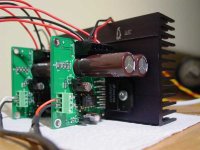I have a total of 20 PCBs available. Pricing will be $15 per board including shipping anywhere in the world.
The boards are double sided 2oz. copper with green solder mask and double sided silk screen. The outer dimensions are 2" x 1.75" (nice and compact). The mounting holes accept 4-40 size screws/standoffs and the mounting hole center spacing is 1.75" x 1.5".
The complete schematic with recommended part values can be found here:
http://www.diyaudio.com/forums/attachment.php?s=&postid=1157922&stamp=1173892828
Some pictures of the PCB are here:
http://www.diyaudio.com/forums/attachment.php?s=&postid=1127582&stamp=1170871665
http://www.diyaudio.com/forums/attachment.php?s=&postid=1127584&stamp=1170871811
A photo of an assembled board is here:
http://www.diyaudio.com/forums/attachment.php?s=&postid=1136995&stamp=1171648436
My current dual mono amp is pictured in the attached photo. Each amp uses the same 24V rails and the fairly small but beefy heatsink (from an old computer) barely gets warm driving my sensitive 8 ohm speakers. The sound quality and imaging are excellent if you use good quality components.
I can/will send a bill of materials to anyone who buys a board.
The boards are double sided 2oz. copper with green solder mask and double sided silk screen. The outer dimensions are 2" x 1.75" (nice and compact). The mounting holes accept 4-40 size screws/standoffs and the mounting hole center spacing is 1.75" x 1.5".
The complete schematic with recommended part values can be found here:
http://www.diyaudio.com/forums/attachment.php?s=&postid=1157922&stamp=1173892828
Some pictures of the PCB are here:
http://www.diyaudio.com/forums/attachment.php?s=&postid=1127582&stamp=1170871665
http://www.diyaudio.com/forums/attachment.php?s=&postid=1127584&stamp=1170871811
A photo of an assembled board is here:
http://www.diyaudio.com/forums/attachment.php?s=&postid=1136995&stamp=1171648436
My current dual mono amp is pictured in the attached photo. Each amp uses the same 24V rails and the fairly small but beefy heatsink (from an old computer) barely gets warm driving my sensitive 8 ohm speakers. The sound quality and imaging are excellent if you use good quality components.
I can/will send a bill of materials to anyone who buys a board.
Attachments
It's an amplifier design based around the venerable LM3875. This particular configuration is known as the classic three op amp instrumentation amplifier. Instrumentation amplfiers are used to convert a differential signal to a single ended signal - exactly what you want an audio amplifier to do. This design can accept single ended or balanced inputs, unlike the standard configurations that can only accept a single ended signal. The instrumentation configuration has some nice advantages I tried to outline here.
One PCB will give you one channel. If you want a stereo amp you need 2 PCBs. If you want 5 channels for a home theater amp you would need 5 PCBs. These would work very well in a home theater amp because both + and - inputs of each amp are high impedance and will not allow ground loops to form (one of the main causes of humming) between the signal source and the amp itself. Of course a balanced source would be even better but most of us don't have one of those.
I've keept 5 boards for myself for just that purpose
One PCB will give you one channel. If you want a stereo amp you need 2 PCBs. If you want 5 channels for a home theater amp you would need 5 PCBs. These would work very well in a home theater amp because both + and - inputs of each amp are high impedance and will not allow ground loops to form (one of the main causes of humming) between the signal source and the amp itself. Of course a balanced source would be even better but most of us don't have one of those.
I've keept 5 boards for myself for just that purpose
- Status
- This old topic is closed. If you want to reopen this topic, contact a moderator using the "Report Post" button.
